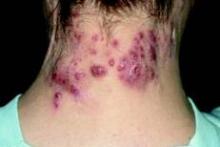Two smaller published case series have boosted to 164 the total number of HS patients treated with similarly "dramatic" results, noted Dr. Jemec. He was an investigator in one of these studies, in which 10 weeks on the antibiotic combination resulted in at least partial improvement in 28 of 34 patients and total remission in 16 (47%). Eight of the 16 relapsed after a mean of 5 months (Dermatology 2009;219:143-7).
Another approach has involved an intensive oral regimen of broad-spectrum antibiotics consisting of rifampin at 10 mg/kg once daily, moxifloxacin at 400 mg/day, and metronidazole at 500 mg three times daily. In a series of 28 consecutive patients with long-standing refractory HS, French investigators prescribed this regimen for 6-12 weeks before switching to consolidation therapy with rifampin and moxifloxacin for 6 more weeks. Complete remission was achieved in 16 of the 28 patients (Dermatology 2011;222:49-58).
"This therapy has yielded remarkably good results in terms of clearance and maintenance of clearance," commented Dr. Jemec.
The main side effects were diarrhea, a complaint in nearly two-thirds of patients, and vaginal candidiasis, which occurred in one-third of treated women.
Topical Clindamycin
Dr. Jemec was a coinvestigator in an early double-blind, 46-patient study that established topical clindamycin as being as effective as oral tetracycline in patients with mild disease (J. Am. Acad. Dermatol. 1998;39:971-4).
Beyond this point, the strength of evidence for proposed HS therapies tails off considerably. But Dr. Jemec deemed a couple of agents worthy of mention on the basis of intriguing yet less than persuasive supporting data:
• Acitretin. In a case series of 12 HS patients treated for 9-12 months at the relatively high dose of 0.6 mg/kg per day of acitretin, with stringent 4-year follow-up, all patients went into remission. In eight patients, the remission lasted for at least 1 year, including a single patient who has been in remission for 4 years and counting (Br. J. Dermatol. 2011;164:170-5). "Remarkable," Dr. Jemec commented.
• Dapsone. This drug is frequently reported anecdotally as being useful in HS, typically with an n-of-1 experience. Dr. Jemec and his coworkers recently published a case series of 24 treated patients, 9 of whom (38%) showed improvement (Dermatology 2011;222:342-6). None of the four severely affected patients improved, however. It was Dr. Jemec’s impression that the degree of improvement was less than he’s seen with combined oral clindamycin and rifampicin. He’d like to see a head-to-head comparison before reaching a final judgment as to a possible role for dapsone.
Dr. Jemec has received research grants from and serves as a consultant to Abbott Laboratories, which is developing adalimumab as a treatment for HS, as well as a dozen other pharmaceutical companies. Dr. Mrowietz is a consultant to Abbott, which funded his study, and to other dermatologic pharmaceutical companies.

